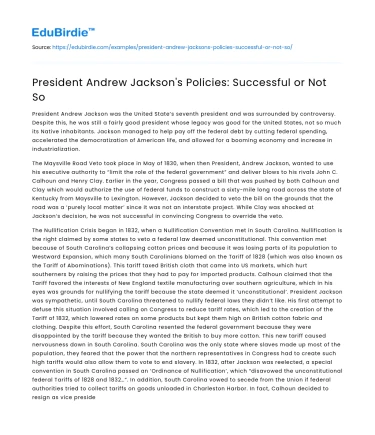President Andrew Jackson was the United State’s seventh president and was surrounded by controversy. Despite this, he was still a fairly good president whose legacy was good for the United States, not so much its Native inhabitants. Jackson managed to help pay off the federal debt by cutting federal spending, accelerated the democratization of American life, and allowed for a booming economy and increase in industrialization.
The Maysville Road Veto took place in May of 1830, when then President, Andrew Jackson, wanted to use his executive authority to “limit the role of the federal government” and deliver blows to his rivals John C. Calhoun and Henry Clay. Earlier in the year, Congress passed a bill that was pushed by both Calhoun and Clay which would authorize the use of federal funds to construct a sixty-mile long road across the state of Kentucky from Maysville to Lexington. However, Jackson decided to veto the bill on the grounds that the road was a ‘purely local matter’ since it was not an interstate project. While Clay was shocked at Jackson’s decision, he was not successful in convincing Congress to override the veto.
Save your time!
We can take care of your essay
- Proper editing and formatting
- Free revision, title page, and bibliography
- Flexible prices and money-back guarantee
The Nullification Crisis began in 1832, when a Nullification Convention met in South Carolina. Nullification is the right claimed by some states to veto a federal law deemed unconstitutional. This convention met because of South Carolina’s collapsing cotton prices and because it was losing parts of its population to Westward Expansion, which many South Carolinians blamed on the Tariff of 1828 (which was also known as the Tariff of Abominations). This tariff taxed British cloth that came into US markets, which hurt southerners by raising the prices that they had to pay for imported products. Calhoun claimed that the Tariff favored the interests of New England textile manufacturing over southern agriculture, which in his eyes was grounds for nullifying the tariff because the state deemed it ‘unconstitutional’. President Jackson was sympathetic, until South Carolina threatened to nullify federal laws they didn’t like. His first attempt to defuse this situation involved calling on Congress to reduce tariff rates, which led to the creation of the Tariff of 1832, which lowered rates on some products but kept them high on British cotton fabric and clothing. Despite this effort, South Carolina resented the federal government because they were disappointed by the tariff because they wanted the British to buy more cotton. This new tariff caused nervousness down in South Carolina. South Carolina was the only state where slaves made up most of the population, they feared that the power that the northern representatives in Congress had to create such high tariffs would also allow them to vote to end slavery. In 1832, after Jackson was reelected, a special convention in South Carolina passed an ‘Ordinance of Nullification’, which “disavowed the unconstitutional federal Tariffs of 1828 and 1832…”. In addition, South Carolina vowed to secede from the Union if federal authorities tried to collect tariffs on goods unloaded in Charleston Harbor. In fact, Calhoun decided to resign as vice president so that he could openly defend nullification in Congress. Jackson was furious, and asked his secretary of war how many soldiers it would take to go and “crush the monster [nullification] in its cradle”, and he continued to denounce nullification due to it being a possible precursor secessions. In response to Jackson’s tirade against nullification many northern states passed resolutions that condemned nullification and even the southern states that had sympathy for South Carolina didn’t endorse nullification. President Jackson eventually sent federal soldiers and even a warship to Charleston to protect the custom house where tariffs were applied to foreign products arriving on ships from Europe and Governor Hayne responded by mobilizing the state militia. This led President Jackson to request the authority to use the US Army to force South Carolina to obey federal law from Congress. Thankfully, Calhoun and the nullifiers eventually backed down, hoping that Congress would pass a better tariff bill for South Carolina.
The Indian Removal Act and the Trail of Tears tie very closely into each other. Both involved President Andrew Jackson’s plan to remove Native Americans from most US land and have them reinstalled onto reservations. In 1830, President Jackson submitted the Indian Removal Act to Congress, this allowed him to “ignore treaty commitments made by previous presidents” and convince the Natives to move to reservations. The Native Americans were not merely forced out into the cold, however, the departing Natives would be compensated and given initial support in their new lands. Naturally, this was met with backlash from both the Natives and political reformers who didn’t trust President Jackson’s motives. Most northern Native Americans obeyed the Indian Removal Act and were relocated, however, Native Americans in Illinois and Wisconsin fought to regain their lands. The Cherokee were also opposed to the Indian Removal Act. The federal officials who were responsible for implementing the Indian Removal Act decided to divide and conquer the Cherokees. In 1838, 17,000 Cherokees were evicted from their lands and were moved West. About 4,000 Cherokees died along the way, and according to one Georgian it was “the cruelest work [he] ever knew”. In December 1838, President Martin van Buren told Congress that he took “sincere pleasure” in being able to report that the entire Cherokee Nation had been relocated. However, some Cherokees held out in the mountains of North Carolina, called the Eastern Band. Years later, the Creeks and Chickasaws would take the same trails and be relocated to reservations. In the end, 100,000 Eastern Indians were relocated to the West during the 1820s and 1830s, and the government sold 100 million acres of Indian land, which was mostly in the Southwest.






 Stuck on your essay?
Stuck on your essay?

